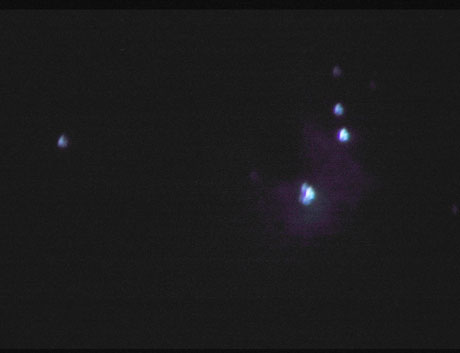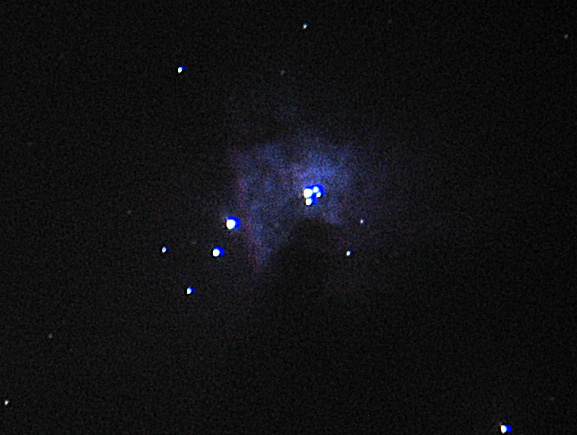Digital Astronomy from Scratch - Deep Sky
26 December 2003
Another attempt at the Orion nebula. The sky was darker than last time (no moon to speak of). I was getting pretty bad vignetting so I had to crop a lot off the frame. Still, it's better than my previous attempts.
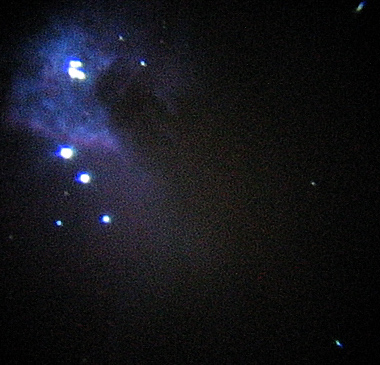
Combination of 6 images, each a 15 second exposure, aligned & stacked in Keith's Image Stacker 3.5 and cropped in Photoshop 7.0. Aperture 3.2, Focal length 7.2mm. Eyepiece projection using Scopetronix digadapt projection adapter and 26mm Televue Plössl eyepiece. Photos taken between 9:25pm and 9:30pm PST.
10 November 2003
Armed with a new adapter from Scopetronix to mount my Canon G3 onto my Meade ETX, I went out and took a test picture of the Orion Nebula. The Moon was out and bright, the seeing wasn't especially good and I live in a light-polluted suburb, but I proved that the ensemble works! This is the best deep space picture I've ever captured. Unfortunately, I didn't record the settings for the camera, but I believe this is a combination of several ten-second exposures. I used eyepiece projection with a 26mm Celestron Plossl.
25 October 2003
Using a Canon PowerShot G3 on a separate tripod, I made some attempts to photograph the Orion Nebula. This is the only one of my attempts that turned out. I think I had enough success that I should consider buying the adapter to more precisely align the camera over the eyepiece. This image is upside down compared to the one below from March 1st, because this time my telescope was properly set up for astronomical use.
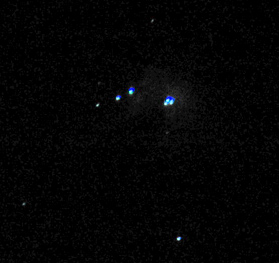
PowerShot G3 set to 5 second exposure, on separate tripod aligned over the eyepiece. Click for a larger version.
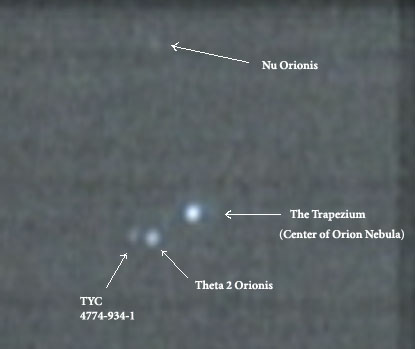
I used my Canon PowerShot G1 handheld over the eyepiece of my Meade ETX to make a 320x240 movie of the Orion Nebula. Any single frame barely shows the brightest spot in the frame (Trapezium, a combination of four stars). But, using the magic of Keith's Image Stacker, I was able to easily align and combine 60 frames to get the image above. Click on the image to see what a single frame looked like (I tried to optimize the single-frame image so you could compare an improved single frame with the stacked image). I used Adobe Photoshop to add the text, crop and zoom. Note that the image is "correct", that is, it's not a mirror image nor is it upside down. I inadvertently was using my Meade ETX in "spotting scope" mode since the last time I used it was for birding. So, imagine a 4" telescope on a standard fixed photography tripod, pointing over the houses in a bright suburban neighborhood. Then imagine unsteadily holding a digital camera over the eyepiece and taking a little movie as the stars moved across the field of view (because the earth is turning), hoping that it was at least partially in focus and aligned reasonably well to the eyepiece. The fact that I got an image at all is pretty amazing. Maybe soon I'll try the same experiment, but with the following changes: use my astronomical tripod with clock drive, use the Scopetronix digital camera mount to hold the camera steadily over the eyepiece, and put the eyepiece in the correct hole in the ETX to use for astronomy. It'll be fun to compare the results, but finding the time for the experiment is the biggest challenge.
28 December 2000
Okay, I really only have one image. It's my first try. Naturally I picked the Orion nebula, since it's out right now and it's really bright. I combined four images taken at 8 seconds apiece (the maximum my digital camera will go to). You can make out the Trapezium in the middle of the purple glow, but all the stars show the same distortion from being out of focus.
